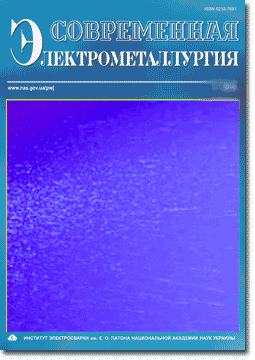Access for download PDF files for subscribers and for reviewers of scientometric bases.
Organization: Elsevier for content access(PDF files of journals released before 2024 are available for download from the website's archives))
Organization: Elsevier for content access(PDF files of journals released before 2024 are available for download from the website's archives))


ELECTROSLAG TECHNOLOGY
Ryabtsev A.D., Troyansky A.A., Korzun E.L., Mastepan V.Yu. and Samborsky M.V. Metal alloying with nitrogen from gas phase in ESR process. P. 2
Using a thermodynamic analysis an attempt was made to evaluate the feasibility of metal nitriding from a gas phase during the electroslag remelting (ESR). It was shown experimentally that in use of slags of Ca-CaF2 system and atmosphere of nitrogen in chamber-type ESR units the necessary conditions are created for transition of nitrogen to metal in the amounts sufficient for nitriding.
Dubodelov V.I., Pogorsky V.K., Shnurko V.K., Zagorovsky P.I., Shabanov V.B., Sviridov O.V., Panchenko V.E. and Gaponov V.G. Application of magnetodynamic unit in the technology of electroslag cladding of steel mill rolls using a liquid metal. P. 7
Different types of equipment for steel casting are considered. The use of a magnetodynamic unit for overheating and pouring of iron-carbon alloys as a link in the technological diagram of the electroslag cladding of mill rolls is offered.
Biktagirov F.K. Application of electroslag process with non-consumable electrodes for melting, refining and treatment of metals. Part 1. P. 9
Technologies of electroslag treatment of metals in which the electroslag process is realized using non-consumable electrodes are considered. The capabilities of electroslag heating and refining of molten metals to improve the metal production quality are shown.
ELECTRON BEAM PROCESSES
Zhuk G.V. and Trigub N.P. New method for dispersing the melt in electron beam units and equipment for its realisation. P. 15
New method for dispersion of the melt from a cold hearth during the electron beam remelting process has been developed. Technological fixture for its realisation in the electron beam furnace has been manufactured. The process of producing aluminium alloy AMg1 ingot by the new method is described. Macro- and microstructures of the resulting sample have been examined.
PLASMA-ARC TECHNOLOGY
Shapovalov V.A., Zhadkevich M.L., Torkhov G.F., Zholud V.V. and Yakusha V.V. Growing of refractory metallic single crystals (Review). P. 17
Basic methods of producing single crystals from refractory metal from vapour, liquid and solid phases are considered. Key attention was paid to the methods of producing crystals from the liquid phase: electron beam zone melting, plasma-arc drop melting, plasma-induction zone melting. It is shown that the technology of plasma-induction zone melting developed at the E.O. Paton Electric Welding Institute of the NAS of Ukraine is the most rational method of producing flat single crystal billets for further manufacturing of single crystal rolled metal (sheet, rods, wire).
Shapovalov V.A. Thermal field of tungsten single crystal in plasma-induction zone melting. P. 24
Mathematical model has been selected for study of thermal fields of single crystals during heating with different sources: plasma-arc, high-frequency and combined plasma + high-frequency. It is shown that the combined heating makes it possible to control the curvature of phase interface. Under certain conditions the surface can become almost plane. The highest efficiency of the thermal field control is attained when all the crystal is heated by an inductor.
GENERAL PROBLEMS OF METALLURGY
Paton B.E. and Medovar L.B. Special electrometallurgy at the beginning of the XXI century. P. 27
An attempt was made to estimate the state-of-the-art and prospects of ferrous metallurgy, including the special electrometallurgy. The step, jumpy nature of the development of metallurgical technologies over the recent decades is shown. A conclusion predicts the approaching next period of a rapid updating of major metallurgical technologies.
Grigorenko G.M., Borisova A.L., Borisov Yu.S., Adeeva L.I., Doroshenko L.K. and Rupchev V.L. Investigation of interphase interaction of ferrotitanium with silicon carbide in powder mixtures used for thermal spray coating. P. 30
Exothermal interaction in FeTi-SiC system was investigated.Maximum exothermal effect was achieved is use of 79 wt.% FeTi + 21 wt.% SiC mixture with the formation of TiC, Ti5Si3-xCx, Fe3Si, Fe5Si3 as products of interaction. The powder mixture of this composition is most challenging for producing composite powders and spraying of thermal coatings with a high wear and corrosion resistance.
Gasik M.M., Zubov V.L. and Gasik M.I. Investigation of phase transformations in commercial ferrosilicium using the method of synchronous thermal analysis. P. 34
Results of experimental study of phase transformations in ferrosilicium of FS45, FS65 and FS70 grades by a synchronous thermal analysis using a differential scanning calorimetry (DSC) and thermogravimetry are considered. Thermal effects occurring in heating and cooling as a result of phase transformations are estimated quantitatively. The change in mass of samples in the process of heating and cooling, and also the heat capacity of ferrosilicium within the temperature 20-1350 oC interval are determined. Comparative analysis of temperature transformations in ferrosilicium of different grades by position of peaks of DSC curves was made.
Rudoj A.P., Melnik V.Kh. and Portnov A.P. Properties of alloys based on high-purity chromium. P. 39
Chromium alloys, alloyed with lanthanum, iron, nickel and cobalt were produced from high-purity chromium ingots melted by induction-arc method. Hardness and transition temperature of these alloys were examined. It is shown that hardness decreased from 1350 to 1000 MPa, and temperature of brittleness decreased from 20 to -40 oC. It is also shown that alloy Cr-La-Fe is easily deformed by rolling and rotational forging. Ductility of this alloy makes it possible to produce the protective coatings from it. Tests of artillery barrels with this protective coating for gunpowder erosion showed the 3 times increase in service life of the barrels.
Index of articles for ASEM'2002, No. 1-4. P. 41
List of authors. P. 42
(You are viewing the simplified file contents)
The cost of subscription/purchase order journals or individual articles
| Journal/Currency | Annual Set | 1 issue printed |
1 issue |
one article |
| TPWJ/USD | 384 $ | 32 $ | 26 $ | 13 $ |
| TPWJ/EUR | 348 € | 29 € | 24 € | 12 € |
| TPWJ/UAH | 7200 UAH | 600 UAH | 600 UAH | 280 UAH |
| AS/UAH | 1800 UAH | 300 UAH | 300 UAH | 150 UAH |
| AS/USD | 192 $ | 32 $ | 26 $ | 13 $ |
| AS/EUR | 180 € | 30 € | 25 € | 12 € |
| SEM/UAH | 1200 UAH | 300 UAH | 300 UAH | 150 UAH |
| SEM/USD | 128 $ | 32 $ | 26 $ | 13 $ |
| SEM/EUR | 120 € | 30 € | 25 € | 12 € |
| TDNK/UAH | 1200 UAH | 300 UAH | 300 UAH | 150 UAH |
| TDNK/USD | 128 $ | 32 $ | 26 $ | 13 $ |
| TDNK/EUR | 120 € | 30 € | 25 € | 15 € |
AS = «Automatic Welding» - 6 issues per year;
TPWJ = «PATON WELDING JOURNAL» - 12 issues per year;
SEM = «Electrometallurgy Today» - 4 issues per year;
TDNK = «Technical Diagnostics and Non-Destructive Testing» - 4 issues per year.





